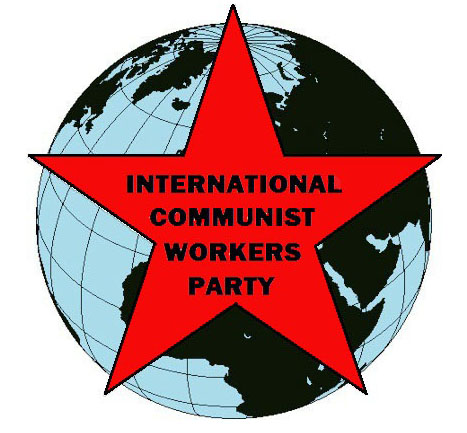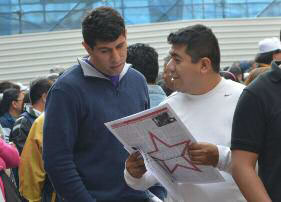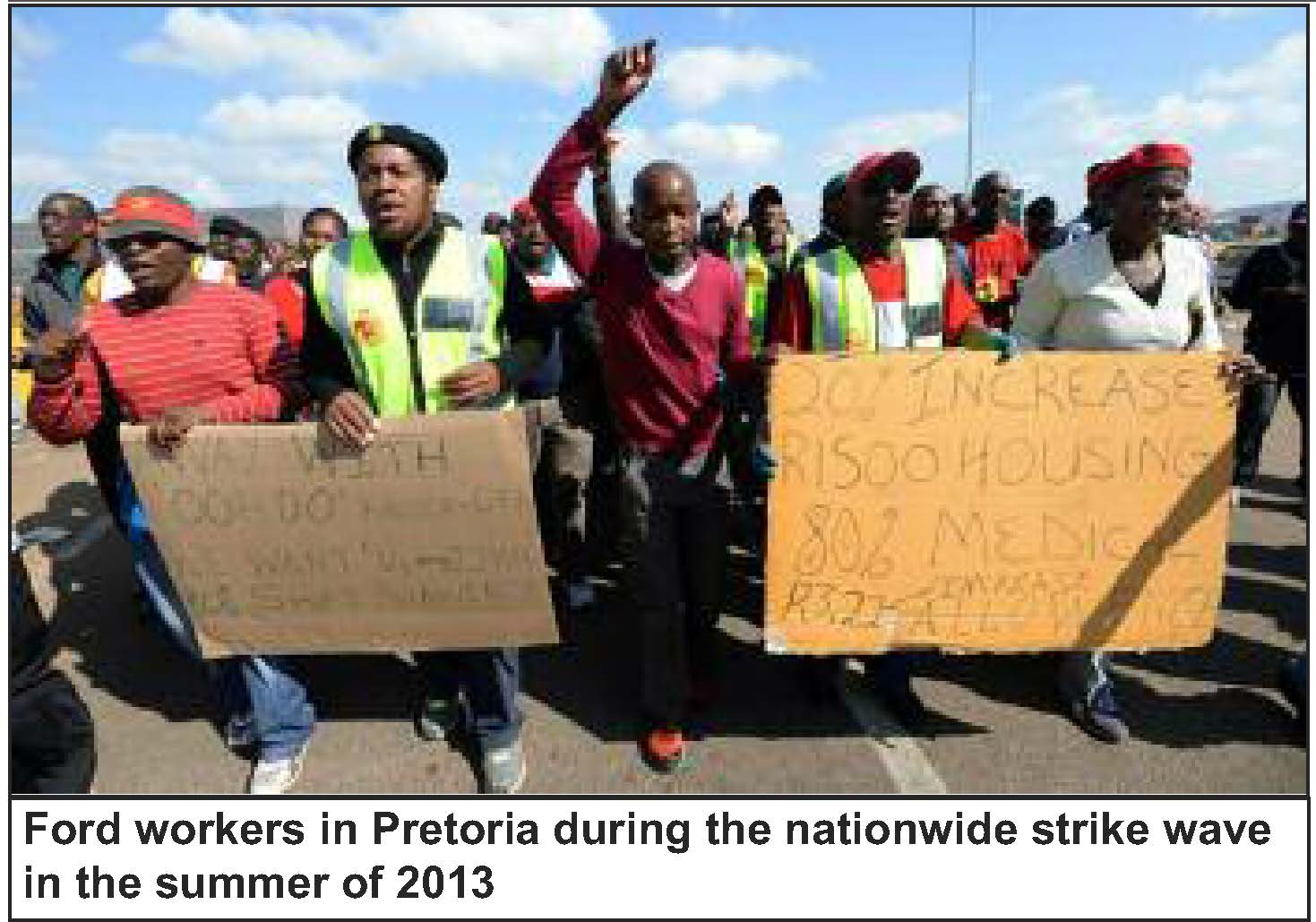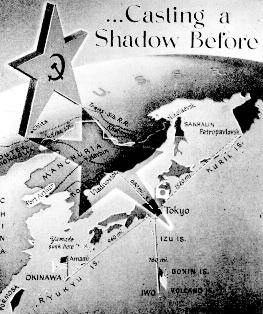
 |
FIGHT FOR COMMUNISM! |
International Communist Workers Party | |

Students Mark 1975 Massacre
SAN SALVADOR, July 30—Once again there was a march to condemn the massacre of students by the dictatorship on July 30, 1975. These students march on this day against the military repression of that time, fighting for the reformist illusion of a better world, like the supporters of the 43 Normal School students of Ayotzinapa, Mexico who were disappeared by the Mexican bosses.
“Reds (fmln) and tricolors (ARENA); the same exploiters,” “The capitalists fear the communists’ advance,” “Long live the martyrs of the 30th of July!” These were some of the slogans that the students of the University of El Salvador shouted in the streets.
Before the march two friends and a member of ICWP mobilized at the university. We made a banner that said, “The people sentence politicians and bourgeois to death,” in the context of the violence and death that descend from the ruling class and its lackeys.
Self-critically didn’t arrange to bring our literature. However, we had good talks and discussions with students throughout the march. We talked about the need to organize for a communist party and leave the reformist and opportunist ideas of the fmln behind, and the idea of establishing a revolutionary radio station, among other things.
The march was divided in two: Those who support the fmln government and those of us who advocate a more radical struggle. “I don’t believe Sanchez Ceren; he helps the bosses and exploits the worker,” was one of the slogans shouted the most in front of the general leadership of the fmln.
This mobilization ended in the exact spot where the students were massacred. As happened in Tlatelolco in Mexico, they don’t really know the exact number of those killed. The laws, at the service of the powerful, have not captured any of the guilty. The communist struggle will bring the killers into the workers’ hands.
After the speech and the burning of a figure of a gorilla—which represents the national guard—the hundreds of students returned to the university in the rain. We spent many hours until late into the night talking with anarchist and communist students in the office of their organization. We shared ideas and contacts. They asked what organization we were from and with pride we responded “from the International Communist Workers’ Party.” They were amazed and said that we were welcome to come whenever we wanted. We interchanged contact information to share our literature.
--Young comrades in El Salvador
Spreading Red Flag Among Health Care Workers

Revolutionary greetings, comrades the world
over. There have been several weeks of absence,
an absence that has not meant abandoning
communist political work. Today with
pleasure I can share with comrades, readers
and friends of the party, a little about the political
work developed in the health care field in
Mexico.
Three months ago I went to work temporarily
in this field, where the idea that every process
takes time was reinforced.
The area in which I work allows me to be in
contact with several workers, from administration
to maintenance, doctors and nurses. This
helped me to get to know and broaden political
discussions with them. Listening to the
workers having discussions about the
national situation has surprised me, as
the situation gets worse.
However, they don’t realize that the
contradiction between the capitalist
bosses internationally and the working
class is crucial to the lives of the
workers in every country.
Self-critically, I have not participated
in some of the discussions since I
don’t yet have enough confidence in
these workers. However, I ask myself,
does it require confidence in these
workers to talk about how rotten this capitalist
system is and what it does with our lives?
In other discussions, I have gotten involved
or have supported them and I have noticed the
workers’ interest in the issues that I mention. I
recognize that I need to know this field more to
have solid arguments since they know better
about this field, but this is not a limitation.
Issues like health, education, the environment,
jobs, poverty, politics, etc., are what
make us workers more similar than different.
Therefore, I have broadened the discussions
to be not just about the health care
field, or just in Mexico. I have discussed
the situation of workers internationally in
every sector. In the best case, this awakened
the interest of some nurses to whom I
have given the newspaper. Next I will also
get it to some doctors. Soon I will leave
this job, but I am certain that we will continue
to take the newspaper to the friends
who are reading it here.
Another self criticism is that I stopped writing,
but I am taking this on again. We need to share
our political work. I did the same thing fully with
a co-worker doctor whom I thanked for his confidence.
I commented to him that the discussions
that we have had are very important.
When a reader from another part of the world
reads the paper and sees that workers in the
health care field in Mexico are learning about
our communist ideas and writing for the paper,
it inspires them.
I thanked him for his openness, like the
nurses who have now allowed me to share this
experience.
Workers of the world, let’s unite in one International
Party! Let’s fight for Communist Revolution!
--Young Comrade in Mexico
South Africa: Communism Shows Workers’ Power

I recently went to Ford to go and distribute the Red Flag. So I went there at lunchtime. I was surprised to find out that most of the workers there don’t go out for lunch. Apparently there are tuck shops inside the factory for workers to buy their lunch there.
Then a thought struck me. Not only do the bosses exploit the workers’ labor but they still want to rob them of their hard-earned money in those expensive tuck shops. As another man puts it you must spend at least 50 Rand a day in order to afford to buy something to eat in those shops, which is almost twice as much as their hourly wage.
So as I was distributing the paper, another old man asked me an interesting question, “How are we, the ICWP, different from the South African Communist Party (SACP)?” Apparently he had a membership card of the SACP. So I told him that the SACP only serves the bosses. They don’t care about the masses. They only want to reform the system. But we on the other side, we want to destroy it, to eradicate the system because capitalism and communism cannot co-exist. It’s a lie to say they can.
And then he asked me how are we going to achieve that because the bosses have all the power. Then I told him that he was wrong. They don’t have the power. It’s only the workers themselves who have the power. But the only way to see that power is for the masses to unite and fight capitalism with communism.
A Comrade
Greetings to Comrades in South Africa
When I open a new copy of Red Flag I always look forward to reading your letters and articles. The growth of our Party among industrial workers in South Africa inspires confidence in the working class everywhere. It encourages the revolutionary optimism we all need to strengthen.
I’m guessing that you probably have a lot of discussions about how communist society will work. That’s usually what leads to recruitment and Party growth.
Is that true? If so, I wish you would write more about those conversations.
What questions do the workers ask? How do you try to answer them? And what would you like other comrades and readers to write about? Together we are blazing a trail toward a new communist future. What do you think it will look like?
As our Party grows in more and more places, Red Flag grows in importance. It’s the main way for us all to be in the same discussion. It’s how we can all help to develop the political line of the Party.
Comrades, your ideas about communism will be helpful to all of us.
—Los Angeles comrade
Criticism of “Racism and Religion” Editorial
I agree with the editorial “Racism and Religion” that only communism can end racism. If I didn’t, I wouldn’t be a proud member of ICWP. But I think the editorial went wrong in a couple of places.
The editorial makes black Christians out to be nincompoops. It says that Blacks are “being promised a better life in the next world,” and “praying for a better world in the afterlife.” I’ve never heard any of this and I’ve gone to a black church for thirty years!
Yes, black churches are reformist and the belief in god is unscientific, but they fall in different places on the political spectrum, from conservative to very progressive. Also the people make up the church and people go for different reasons: social, political, cultural, not just religious. It’s not like all or most are just waiting for heaven and not doing anything here on Earth. Take Denmark Vesey, and Jeremiah Wright, the progressive Chicago pastor that Obama hurried to distance himself from.
I also didn’t think the editorial did a good job explaining the idea of the politics of forgiveness, which supposedly permeates black churches and explains both why the families of the victims of the Charleston massacre forgave the murderer Dylann Roof and why the Civil Rights Movement was nonviolent. Maybe the idea wasn’t explained well because it wasn’t Red Flag’s idea. You-all were quoting some professor. I think the editorial should have put the paper’s ideas across instead. The article about Bishop Romero shed light on the Catholic Church in El Salvador, but the editorial did not do much to further our understanding of the black church.
--Bay Area Comrade
Obama on Black Churches: Deflecting Black Workers’ Anger
At the funeral for the victims of the Charleston, SC, church massacre, Obama delivered a bravura performance in the interests of US capitalist rulers before a receptive church audience.
He praised the politics of State Senator Clementa Pinckney, “that was neither mean, nor small. He conducted himself quietly, and kindly, and diligently. He encouraged progress not by pushing his ideas alone but by seeking out your ideas…He was full of empathy…able to walk in somebody else’s shoes…”
Obama pushed electoral politics to the masses and implied that an effective Black elected official does not attack racism or challenge the status quo of capitalism—in other words be militant. In his elected office, gentle, quiet, diligent Senator Pinckney actually worked to maintain and sustain capitalism.
About the history of the Black Church, Obama said, “Black churches served as hush harbors where slaves could worship in safety; praise houses where their free descendants could gather and shout hallelujah…no better example of this tradition than Mother Emanuel—a church built by blacks seeking liberty, burned to the ground because its founder sought to end slavery, only to rise up again, a Phoenix from these ashes.”
What is most glaring here is that Obama omits the name of Denmark Vesey, a former slave and founder of Mother Emanuel, who preached a theology of armed insurrection against slavery and planned a rebellion of enslaved persons. Obama had to acknowledge some of Mother Emanuel’s history, yet leave out the struggle against slavery and racism: Vesey’s militancy might give workers ideas.
Obama said that Black churches “have been and continue to be community centers where we organize for jobs and justice…” This is a deceptive illusion that a capitalist legal system can somehow serve both the exploiters and the exploited. “Justice” under capitalism consists of a whole system of laws, courts, cops, and prisons that exist to protect the wealth and
property of the ruling class. No matter what is preached from any church pulpit, there is no justice for the working class under capitalism.
Obama played his role in deflecting workers’ anger and possible rebellions (as in Ferguson, Baltimore and other cities across the US) about the Charleston massacre.
We in ICWP must struggle even harder to take communism to the masses and win them to the fight to destroy capitalism, the source of racism.
--Veteran Bay Area Comrade
August, 1945: US Imperialists Murdered 100,000 Japanese Civilians to Threaten the Soviet Union

August 6--This week, the world remembers the seventieth anniversary of the US atomic bombing of Hiroshima and Nagasaki, in which more than one hundred thousand civilians died horribly. This was the culmination of US fire bombings of Japan which had taken half a million lives over the previous year and a half,. It shows the racist disregard for human life which characterized the US war in the Pacific.
The illustration to the left, from Time magazine, April, 1945, explains the timing of this attack. German surrender was imminent (Germany surrendered on May 8). The Soviet Union had agreed to declare war on Japan 90 days after the end of the war in Europe. The US was already faced with sharing the occupation of Europe with the Soviet Red Army, which had done the bulk of the fighting and dying in the battle against Nazi Germany. It refused to share its victory in the Pacific with the Soviets as well. The bombing of Hiroshima and Nagasaki signaled not only the end of World War II, but the beginning of the Cold War between the US and the USSR. For the US rulers, 100,000 more dead Japanese civilians were acceptable collateral damage.
The US media will be publicizing photographs of the devastation of Hiroshima and Nagasaki this week. We should recognize them as evidence of the willingness of the US bosses to commit mass murder to maintain their empire, faced with rivals abroad or revolution within. Our response must be, “Let the imperialists start their wars. We will end them.”